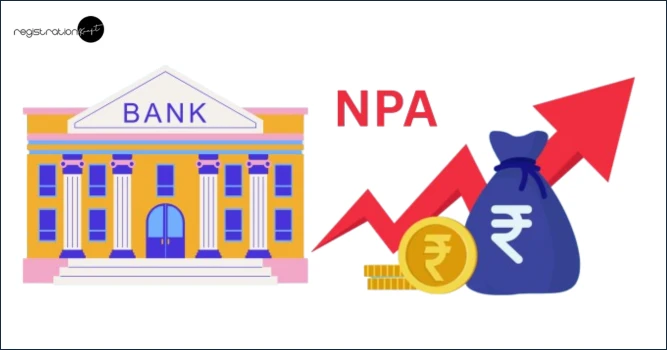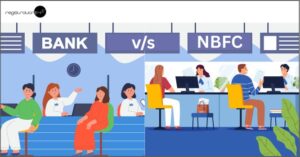What are the Non-Performing Assets of Bank

Banks are the backbone of any economy. They provide loans to individuals, businesses, and governments to help fuel economic growth. But what happens when borrowers stop repaying those loans? That’s when a loan can turn into Non-Performing Assets (NPA).
In this article, we’ll break down what non-performing assets in a bank actually mean, how they are classified, the types of NPAs, and what happens if your account goes NPA — all in a way that’s easy to understand.
Non-Performing Assets of Bank
Simply put, non-performing assets of a bank are loans or advances given by a bank that stop generating income. Normally, when a bank gives out a loan, it expects to receive regular interest payments along with the repayment of the principal amount. If a borrower fails to make interest or principal payments for 90 days or more, the asset is classified as “non-performing.”
Understand NPA With an Example
Let’s say a bank gives a personal loan to Raj of ₹2 lakh, and the EMI is due every month. If Raj doesn’t pay any EMI for three straight months (i.e., 90 days), that loan becomes a Non-Performing Asset. From that point, the bank stops earning from that loan — it becomes a liability rather than an asset.
Non-Performing Assets Classification
Not all NPAs are the same. The non-performing assets classification helps banks understand the seriousness of the situation. NPAs are usually classified into the following categories:
1.Substandard Asset 2. Doubtful Asset 3. Loss Asset
When a borrower fails to repay a loan or the interest for more than 90 days, the bank marks that loan as a Non-Performing Asset (NPA). Among NPAs, there are three main categories based on how long the payment has been overdue and how likely the bank is to recover the money. The first stage is called a Substandard Asset. These are loans that have remained unpaid for up to 12 months after becoming an NPA. At this stage, the risk is moderate, and the bank still has hope that the borrower might repay if given some help or extra time.
If the loan stays unpaid for more than 12 months after becoming a substandard asset, it moves into the second category, called a Doubtful Asset. At this point, the bank begins to lose confidence in the borrower’s ability to repay. The chances of recovery become much lower, and the loan is seen as risky. The longer the delay, the more serious the situation becomes.
The final stage is called a Loss Asset. These are loans where the bank or its auditor has decided that the money cannot be recovered at all. The bank accepts that it is a loss, although the loan may still remain in the books for some time before being officially written off. For example, this could happen if the borrower’s business has shut down, their assets have no value, or they cannot be found. In this case, the bank may have to absorb the loss and move on.
Non-Performing Assets Types
There are mainly four non-performing assets types that banks deal with:
1. Term Loans
Term loans are loans granted for a fixed period (usually medium to long term) with regular repayment schedules, either monthly, quarterly, or yearly.
When Do They Become NPAs?
- A term loan becomes a non-performing asset if the borrower fails to make any principal or interest payment for more than 90 days.
- For example, if a borrower misses three consecutive monthly payments, the loan is classified as an NPA.
Why It Matters
Term loans are generally used for capital expenditures such as buying machinery, vehicles, or property. Non-payment affects the bank’s cash flow and may indicate financial stress for the borrower.
2. Overdraft and Cash Credit Accounts
- Overdraft (OD): A facility allowing customers to withdraw more than their account balance up to a certain limit.
- Cash Credit (CC): A short-term loan facility where the borrower can withdraw money up to a sanctioned limit, usually against inventory or receivables.
When Do They Become NPAs?
- These accounts become NPAs if no transactions (debit or credit) are recorded for 90 days or more.
- In other words, if the borrower stops using the facility and does not repay the outstanding amount or operate the account for 90 days, it is classified as non-performing.
Why It Matters
These are working capital loans meant to support day-to-day business operations. Non-operation or non-repayment signals liquidity problems for the borrower.
3. Bills Purchased and Discounted
- These are short-term credit facilities where banks purchase bills of exchange or promissory notes from customers before maturity at a discount.
- The customer gets immediate funds, and the bank collects payment from the bill’s drawee on maturity.
When Do They Become NPAs?
- If the bills remain unpaid for more than 90 days past the due date, they are classified as NPAs.
- This means the bank has not received the expected payment from the party responsible for settling the bill.
Why It Matters
Bills purchased and discounted are crucial for trade finance. Non-payment disrupts the bank’s liquidity and can indicate problems in the borrower’s business or the drawee’s creditworthiness.
4. Agricultural Advances
- Loans extended to farmers for agricultural activities such as crop production, purchase of seeds, fertilizers, equipment, etc.
- These advances are usually short-term and linked to crop cycles.
When Do They Become NPAs?
- For short duration crops, if the principal or interest is not paid for two crop seasons, the loan is classified as an NPA.
- For long duration crops, non-payment for one crop season leads to classification as an NPA.
- Crop seasons vary depending on the type of crop and region.
Why It Matters
Agricultural advances are vital for rural economies. Delays or defaults often arise due to factors like poor harvests, weather conditions, or market prices, affecting both farmers and banks.
What Happens If My Account Goes to NPA?
This is a concern for many borrowers. What happens if my account goes NPA?
Here’s what you need to know:
- Credit Score Drops: A big red flag for future loans.
- Recovery Notices: The bank may begin the recovery process.
- Legal Action: The bank can take legal steps to recover dues, including auctioning any collateral.
- No Fresh Loans: You may be barred from getting loans or credit cards in the future.
It’s always better to talk to your bank and work out a repayment plan before things go this far.
Provision for Non-Performing Assets
When loans turn into NPAs, banks don’t just sit idle. They are required to set aside a certain amount of money as provision for non-performing assets. This means a part of their profit is kept aside to cover potential losses from these bad loans.
These provisions impact the bank’s profitability but help ensure the bank remains financially healthy even if many loans go bad.
Conclusion
Understanding what non-performing assets of a bank is important not just for bankers, but also for borrowers. When loans turn into NPAs, it’s a warning sign — both for the bank and the borrower.
By understanding non-performing assets classification, knowing the types, and being aware of the provision for non-performing assets, borrowers can take proactive steps to avoid falling into the NPA category. If your account is heading in that direction, don’t wait — contact your bank and seek help.
Staying informed is the first step towards staying financially safe.
Related Post : What is an Asset Reconstruction Company
Categories: Banking
Tags:





